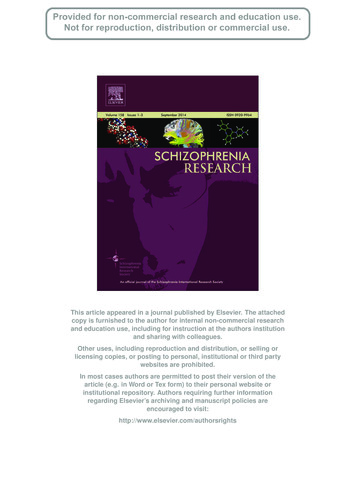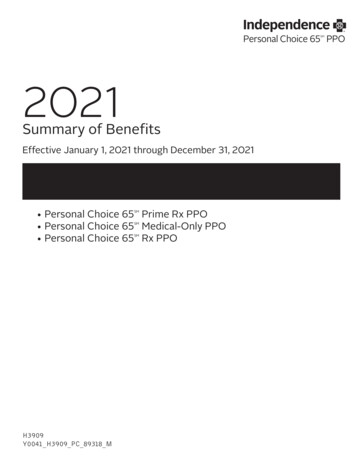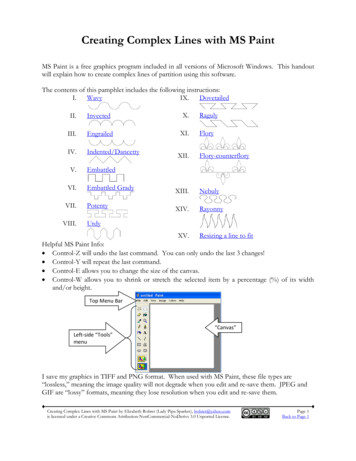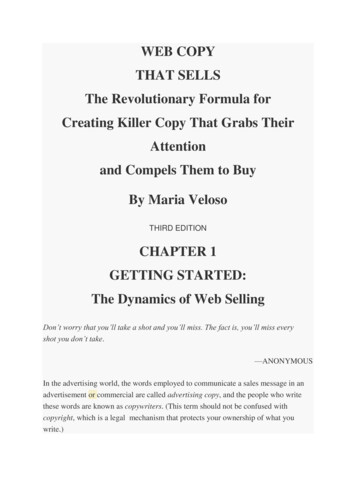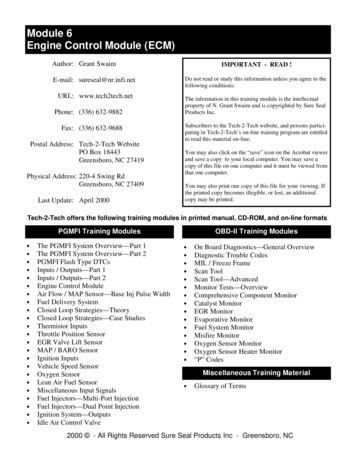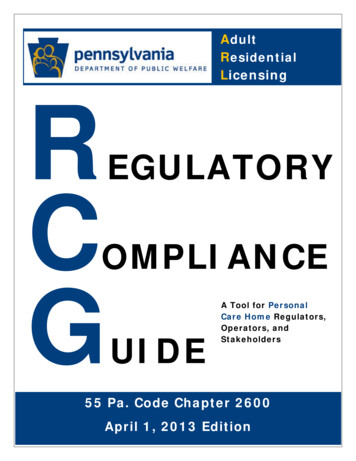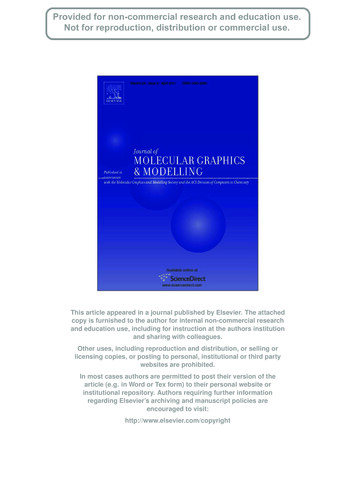
Transcription
This article appeared in a journal published by Elsevier. The attachedcopy is furnished to the author for internal non-commercial researchand education use, including for instruction at the authors institutionand sharing with colleagues.Other uses, including reproduction and distribution, or selling orlicensing copies, or posting to personal, institutional or third partywebsites are prohibited.In most cases authors are permitted to post their version of thearticle (e.g. in Word or Tex form) to their personal website orinstitutional repository. Authors requiring further informationregarding Elsevier’s archiving and manuscript policies areencouraged to visit:http://www.elsevier.com/copyright
Author's personal copyJournal of Molecular Graphics and Modelling 29 (2011) 843–864Contents lists available at ScienceDirectJournal of Molecular Graphics and Modellingjournal homepage: www.elsevier.com/locate/JMGMDiscovery of new renin inhibitory leads via sequential pharmacophore modeling,QSAR analysis, in silico screening and in vitro evaluationAfaf H. Al-Nadaf a , Mutasem O. Taha b, abDepartment of Medicinal Chemistry and Pharmacognosy, Faculty of Pharmacy, Applied Science University, Amman, JordanDrug Discovery Unit, Department of Pharmaceutical Sciences, Faculty of Pharmacy, University of Jordan, Amman, Jordana r t i c l ei n f oArticle history:Received 11 July 2010Received in revised form 31 January 2011Accepted 3 February 2011Available online 13 February 2011Keywords:ReninPharmacophore modelingQSARIn silico screeninga b s t r a c tThe renin–angiotensin–aldosterone system is a major target for the clinical management of hypertension.Development of renin inhibitors has proven to be problematic due to poor bioavailability and complex synthesis. In this study, we combined pharmacophore modeling and quantitative structure–activityrelationship (QSAR) analysis to explore the structural requirements for potent renin inhibitors employing 119 known renin ligands. Genetic algorithm and multiple linear regression analysis were employedto select an optimal combination of pharmacophoric models and physicochemical descriptors to yieldself-consistent and predictive QSAR. Two binding pharmacophore models emerged in the optimal QSAR222equation (r96 0.746, F-statistic 43.552, rLOO 0.697, rPRESSagainst 23 test inhibitors 0.527). The successful pharmacophores were complemented with exclusion spheres to optimize their receiver operatingcharacteristic curve (ROC) profiles. The QSAR equations and their associated pharmacophore models werevalidated by the identification and experimental evaluation of new promising renin inhibitory leadsretrieved from the National Cancer Institute (NCI) structural database. The most potent hits illustratedIC50 value of 2.6 M. Successful pharmacophore models were found to be comparable with crystallographically resolved renin binding pocket. 2011 Elsevier Inc. All rights reserved.1. IntroductionThe renin–angiotensin system (RAS) is a major regulator ofblood pressure; it has a renoprotective role and an important rolein the vascular response to injury [1]. Renin belongs to the aspartic proteases, which comprise one of the four primary classes ofpeptide cleaving enzymes [2]. It is secreted by the kidneys inresponse to decrease in circulating volume and blood pressure.Renin cleaves the substrate angiotensinogen to form the inactiveangiotensin I. Angiotensin I is converted to the pro-hypertensiveagent angiotensin II by angiotensin converting enzyme (ACE) [3].Therefore, renin is a key player in the renin–angiotensin system,and its manipulation provides a means for the therapeutic treatment of hypertension and heart failure [4,5].Renin inhibition is an attractive target for drug intervention dueto its remarkable specificity for its substrate, which should reduceunwanted interactions and side effects [4]. In contrast, ACE is implicated in several pathways, and therefore, its inhibition results inside effects [2,3,6]. Corresponding author. Tel.: 962 6 5355000x23305; fax: 962 6 5339649.E-mail address: mutasem@ju.edu.jo (M.O. Taha).1093-3263/ – see front matter 2011 Elsevier Inc. All rights reserved.doi:10.1016/j.jmgm.2011.02.001Earlier renin inhibitors were mainly peptidomemtic [7,8]. However, the unfavorable pharmacokinetic behavior of peptidomemticinhibitors prompted continuous efforts towards developing nonpeptidic renin inhibitors. These culminated in the development ofaliskiren, Fig. 1, a nonpeptidic sub-nanomolar renin modulator ofacceptable oral bioavailbility [2,9].Nevertheless, development of renin inhibitors has faced manyproblems: the high cost of synthesis, low and variable bioavailability and lack of appropriate animal models [10,11]. Developmentefforts relied mainly on classical rational drug design [10,12,13]and structure-based concepts [9,11,14] with only one ligand-basedexception that relied on CoMFA and CoMSIA [15]. A recent studycombined docking and QSAR to attempt developing predictivemodel for rennin inhibitors [73]. The first renin crystallographicstructure was determined by Sialecki et al. at a resolution of 2.5 Å[15]. Subsequent crystallographic studies achieved better resolutions [16–22].The continued interest in designing new renin inhibitors combined with drawbacks of structure-based design [23–27], e.g.,limitations in dealing with the induced fit flexibility of renin[11,19], and inappropriateness of CoMFA and CoMSIA modelsas search queries to mine virtual three-dimensional (3D) structural databases [15,28], prompted us to explore the possibility ofdeveloping ligand-based 3D pharmacophore(s) integrated within
Author's personal copy844A.H. Al-Nadaf, M.O. Taha / Journal of Molecular Graphics and Modelling 29 (2011) 843–864O2.1.1. Software and hardwareThe following software packages were utilized in the presentresearch.(S)(S)(S)OOHNH2NNH2OH(R)OOFig. 1. Aliskiren.self-consistent QSAR model. The pharmacophore model(s) can beused as 3D search query(ies) to mine 3D libraries for new renininhibitors, while the associated QSAR model can be used to predictthe bioactivities of captured hits and therefore prioritize them forin vitro evaluation. We previously reported the successful use ofthis combination to probe the induced fit flexibilities of activatedfactor X (fXa) [29] and towards the discovery of new inhibitoryleads against glycogen synthase kinase 3 (GSK-3 ) [30], hormonesensitive lipase (HSL) [31], bacterial MurF [32], protein tyrosinephosphatase 1B (PTP 1B) [33] and influenza neuraminidase [34],beta-secretase [35] and cholesteryl ester transfer protein [36].We employed the HYPOGEN module from the CATALYST software package to construct numerous plausible binding hypothesesfor renin inhibitors [20–22,37–40]. Subsequently, genetic function algorithm (GFA) and multiple linear regression (MLR) analysiswere employed to search for optimal QSAR that combines highquality binding pharmacophores with other molecular descriptorsand capable of explaining bioactivity variation across a collectionof diverse renin inhibitors.QSAR-selected pharmacophores were further validated by comparing them with crystallographic structures of renin boundto known inhibitors, and evaluating their ability to successfully classify a list of compounds as actives or inactives (i.e., byassessing their receiver operating characteristic (ROC) curves).Subsequently, the optimal pharmacophores were complementedwith exclusion spheres to enhance their ROC profiles. Thereafter, the resulting exclusion spheres-complemented modelswere used as 3D search queries to screen the national cancer institute (NCI) virtual molecular database for new renininhibitors.2. Materials and methods2.1. Molecular modelingCATALYST models drug–receptor interaction using informationderived only from the drug structure [28,41–45]. HYPOGEN identifies a 3D array of a maximum of five chemical features commonto active training molecules, which provides a relative alignmentfor each input molecule consistent with their binding to a proposed common receptor site. The chemical features consideredcan be hydrogen-bond donors and acceptors (HBDs and HBAs,respectively), aliphatic and aromatic hydrophobes (Hbic features),positive and negative charges, positive and negative ionizablegroups and aromatic planes. CATALYST pharmacophores have beenused as 3D queries for database searching and in 3D-QSAR studies[29–32,46]. CATALYST (Version 4.11), Accelrys Inc. (www.accelrys.com), USA. CERIUS2 (Version 4.10), Accelrys Inc. (www.accelrys.com), USA. ambridgesoft.Com), USA. Pharmacophore and QSAR modeling studies were performedusing CATALYST (HYPOGEN module) and CERIUS2 software suitesfrom Accelrys Inc. (San Diego, California, www.accelrys.com)installed on a Silicon Graphics Octane2 desktop workstationequipped with a dual 600 MHz MIPS R14000 processor (1.0 GBRAM) running the Irix 6.5 operating system. Structure drawing was performed employing ChemDraw Ultra 6.0 which wasinstalled on a Pentium 4 PC.2.1.2. Data setThe structures of 119 renin inhibitors (Fig. 2 andTable A under Supplementary Materials) were collected fromarticles published by a single research group [20–22,37–40],which strongly supports the notion that their in vitro bioactivitieswere determined by a single assay procedure. The bioactivitieswere expressed as the concentration of the test compound thatinhibited the activity of renin by 50% (IC50 ). Table A in Supplementary Information and Fig. 2 show the structures and IC50 values ofthe considered inhibitors. The logarithm of measured IC50 (nM)values were used in pharmacophore modeling and QSAR analysis,thus correlating the data linear to the free energy change.The two-dimensional (2D) chemical structures of the inhibitorswere sketched using ChemDraw Ultra, installed on a PC, andsaved in MDL-mol file format. Subsequently, they were importedinto CATALYST, converted into corresponding standard 3D structures and energy minimized to the closest local minimum usingthe molecular mechanics CHARMm force field implemented inCATALYST. The resulting 3D structures were utilized as startingconformers for conformational analysis.2.1.3. Conformational analysisThe molecular flexibilities of the collected compounds weretaken into account by considering each compound as a collectionof conformers representing different areas of the conformationalspace accessible to the molecule within a given energy range.Accordingly, the conformational space of each inhibitor (1–119,Fig. 2 and Table A under Supplementary Materials) was exploredadopting the “best conformer generation” option within CATALYST.Default parameters were employed in the conformation generationprocedure, i.e., a conformational ensemble was generated with anenergy threshold of 20 kcal/mol from the local minimized structure which has the lowest energy level and a maximum limit of250 conformers per molecule [41].2.1.4. Pharmacophoric hypotheses generationAll 119 molecules with their associated conformational models were regrouped into a spreadsheet. The biological data of theinhibitors were reported with an “Uncertainty” value of 3, whichmeans that the actual bioactivity of a particular inhibitor is assumedto be situated somewhere in an interval ranging from one-thirdto three-times the reported bioactivity value of that inhibitor[43,45,47]. CATALYST requires the uncertainty parameter for twopurposes: (i) as means to classify the training compounds intomost-active, moderate and inactive categories, which is essential for the three modeling phases of CATALYST (see SM-1 underSupplementary Materials), and (ii) as means to define the tolerance sizes of the binding features’ spheres in the resultingpharmacophore. The default value of this parameter is 3. Typically,
Author's personal copyA.H. Al-Nadaf, M.O. Taha / Journal of Molecular Graphics and Modelling 29 (2011) 843–864CATALYST requires informative training sets that include at least16 compounds of evenly spread bioactivities over at least threeand a half logarithmic cycles [43,45,47]. Four structurally diversetraining subsets (Table 3) were carefully selected from the collectedcompounds for pharmacophore modeling.Each training subset was utilized to conduct four modeling runsto explore the pharmacophoric space of renin inhibitors. Differenthypotheses were generated by altering the interfeature spacing andthe number of allowed features in the resulting pharmacophores(see Table B under Supplementary Materials).Eventually, our pharmacophore exploration efforts (16 automatic runs, Table 3 and Table B in Supplementary Materials)culminated in 160 pharmacophore models of variable qualities (seeSM-1 under Supplementary Materials for details about CATALYSTpharmacophore generation algorithm [43,45,47]).2.1.5. Assessment of the generated hypothesesWhen generating hypotheses, CATALYST attempts to minimizea cost function consisting of three terms: weight cost, error cost andconfiguration cost (see SM-2 pharmacophore assessment in CATALYST under Supplementary Materials [41,45,48]). In a successfulautomatic modeling run, CATALYST ranks the generated modelsaccording to their total costs [41].CATALYST also calculates the cost of the null hypothesis, whichpresumes that there is no relationship in the data and that experimental activities are normally distributed about their mean.Accordingly, the greater the difference from the cost of the nullhypothesis, the more likely that the hypothesis does not reflect achance correlation.CATALYST-HYPOGEN implements additional approach to assessthe quality of resulting pharmacophores, namely, the Cat-ScrambleOOOONH2NOH 2NHOO845R1NHNOO12 -3HNNH 4OR1OR2R135-50Fig. 2. The chemical scaffolds of training compounds, the corresponding structures and bioactivities are as in Table A in Supplementary Materials.
Author's personal copy846A.H. Al-Nadaf, M.O. Taha / Journal of Molecular Graphics and Modelling 29 (2011) 843–864H2NNR1NNNH2FOOOR4OO51-63HNOOR1OO64 -8 8HNO R1NOOOOOOOHNOR3R1NFNR2HNN89-9495 -9 8HNR1ONR1NOOOOOOO9 9 - 10 7108-11 1HNR1NHOOO112-119Fig. 2. (Continued).approach. This validation procedure is based on Fisher’s randomization test [47]. In this test, a 95% confidence level wasselected, which instructs CATALYST to scramble the bioactivitiesof training compounds to generate 19 random spreadsheets. Subsequently, CATALYST-HYPOGEN is challenged to use these randomspreadsheets to generate hypotheses using exactly the same features and parameters used in generating pharmacophore modelsfrom unscrambled bioactivity data. Success in generating pharmacophores of comparable cost criteria to those produced by theoriginal unscrambled data reduces the confidence in the training
Author's personal copyA.H. Al-Nadaf, M.O. Taha / Journal of Molecular Graphics and Modelling 29 (2011) 843–864compounds and their respective pharmacophore models [41,59].Only 62 pharmacophores, out of 160 generated models, werefound to possess Fisher confidence values 85%. Table C in Supplementary Materials shows the success criteria of representativepharmacophores from each run.2.1.6. Clustering of the generated pharmacophore hypothesesThe successful models (62) were clustered into 12 groupsutilizing the hierarchical average linkage method available in CATALYST. Therefore, closely related pharmacophores were groupedin five-membered clusters. Subsequently, the highest-ranking representatives, as judged based on their fit-to-bioactivity correlationr2 -values (calculated against collected compounds 1–119), wereselected to represent their corresponding clusters in subsequentQSAR modeling (Table C in Supplementary Materials).2.1.7. QSAR modelingA subset of 96 compounds from the total list of inhibitors(1–119) was utilized as a training set for QSAR modeling. However,since it is essential to assess the predictive power of the resulting QSAR models on an external set of inhibitors, the remaining23 molecules (ca. 20% of the dataset) were employed as an external test subset for validating the QSAR models. The selected testinhibitors are: 10, 11, 21, 33, 36, 45, 46, 48, 61, 65, 72, 76, 84, 88,101, 102, 106, 107, 108, 111, 114, 115 and 116 (numbers are as inTable A in Supplementary Materials and Fig. 2).The test molecules were selected as follows: the collectedinhibitors (1–119, Table A in Supplementary Materials and Fig. 2)were ranked according to their IC50 values, and then everyfifth compound was selected for the test set starting from thehigh-potency end. This selection considers the fact that the testmolecules must represent a range of biological activities similar tothat of the training set.The chemical structures of the inhibitors were imported intoCERIUS2 as standard 3D single conformer representations in SDformat. Subsequently, different descriptor groups were calculated for each compound employing the C2.DESCRIPTOR moduleof CERIUS2. The calculated descriptors were 128 properties (seesection SM-4 under Supplementary Materials) that included various simple and valence connectivity indices, electro-topologicalstate indices and other molecular descriptors (e.g., logarithm of partition coefficient, polarizability, dipole moment, molecular volume,molecular weight, molecular surface area, energies of the lowestand highest occupied molecular orbitals, etc.) [47]. Furthermore,the training compounds were fitted (using the Best-fit option inCATALYST) against the representative pharmacophores (12 models, Table C in Supplementary Materials), and their fit valueswere added as additional descriptors. The fit value for any compound is obtained automatically via equation (D) in SupplementaryMaterials [41].Genetic function approximation (GFA) was employed to searchfor the best possible QSAR regression equation capable of correlating the variations in biological activities of the training compoundswith variations in the generated descriptors, i.e., multiple linearregression modeling (MLR). The fitness function employed hereinis based on Friedman’s ‘lack-of-fit’ (LOF) [47]. However, to avoidoverwhelming GFA-MLR with large number of poor descriptors;we removed 50% of those showing lowest variance prior to QSARanalysis.We were obliged to normalize the potencies of the trainingcompounds via division by their corresponding molecular weights,i.e., ligand efficiency (Log(1/IC50 )/Mwt), to achieve reasonable selfconsistent QSAR models [35,49,50].Our preliminary diagnostic trials suggested the following optimal GFA parameters: explore linear, quadratic and spline equationsat mating and mutation probabilities of 50%; population size 500;847number of genetic iterations 30,000 and lack-of-fit (LOF) smoothness parameter 1.0. However, to determine the optimal numberof explanatory terms (QSAR descriptors), it was decided to scan andevaluate all possible QSAR models resulting from 4 to 20 explanatory terms.All QSAR models were validated employing leave one-out2 ), bootstrapping (r 2 ), leave 25%-out crosscross-validation (rLOOBS22validation (rL25%O ) and predictive r2 (rPRESS) calculated from therandomly selected external test subset (see selection criteria mentioned earlier).2In rL25%Oprocedure the training set is divided into two subsets:fit and test subsets. The test subset is randomly selected to represent 25% of the training compounds. This procedure is repeatedover four cycles; accordingly, four test subsets with their complementary fit subsets were selected for the particular QSAR model.The four test subsets should cover 100% of the training compoundsby avoiding selecting the same compound in more than one testsubset. The fit sets are then utilized to generate four QSAR submodels using the same descriptors. The resulting sub-models arethen utilized to predict the bioactivities of the corresponding testing subsets. Finally, the predicted values of all four test subsets arecorrelated with their experimental counterparts to determine the2corresponding rL25%O.2On the other hand, predictive rPRESSis defined as:2rPRESS SD PRESSSD(1)Where SD is the sum of the squared deviations betweenthe biological activities of the test set and the mean activity of the training set molecules, PRESS is the squareddeviations between predicted and actual activity valuesfor every molecule in the test set.2.1.8. Receiver operating characteristic (ROC) curve analysisSuccessful QSAR-selected pharmacophore models (i.e., Hypo1/5and Hypo1/7) were validated by assessing their abilities to selectively capture diverse renin inhibitors from a large list of decoysemploying ROC analysis.Therefore, it was necessary to prepare valid evaluation structural database (testing set) that contains an appropriate list of decoycompounds in combination with diverse list of known active compounds. The decoy list was prepared as described by Verdonk andco-workers [51,52]. Briefly, the decoy compounds were selectedbased on three basic one-dimensional (1D) properties that allowthe assessment of distance (D) between two molecules (e.g., i andj), namely: (1) the number of hydrogen-bond donors (NumHBD);(2) number of hydrogen-bond acceptors (NumHBA) and (3) countof nonpolar atoms (NP, defined as the summation of Cl, F, Br, I, Sand C atoms in a particular molecule). For each active compound inthe testing set, the distance to the nearest other active compoundis assessed using their Euclidean distance (equation (2)):D(i, j) 22(NumHBDi NumHBDj ) (NumHBAi NumHBAj ) (NPi NPj )2(2)The minimum distances are then averaged over all active compounds (Dmin). Subsequently, for each active compound in thetesting set an average of 20 decoys were randomly chosen fromthe ZINC database [53]. The decoys were selected in such a waythat they did not exceed Dmin distance from their correspondingactive compound.Moreover, to further diversify the actives members, i.e., to avoidclose similarity among actives in the testing set, any active compound having zero distance (D(i,j)) from other active compound(s)in the testing set were excluded. Active testing compounds weredefined as those possessing renin affinities (IC50 values) ranging
Author's personal copy848A.H. Al-Nadaf, M.O. Taha / Journal of Molecular Graphics and Modelling 29 (2011) 843–864from 0.067 nM to 100 nM. The testing set included 12 active compounds and 238 ZINC compounds.The testing set (250 compounds) was screened by each pharmacophore for ROC analysis employing the “Best flexible search”option implemented in CATALYST, while the conformational spacesof the compounds were generated employing the “Fast conformation generation option” implemented in CATALYST. Compoundsmissing one or more features were discarded from hit lists. Thein silico hits were scored employing their fit values (best-fit values) as calculated by equation (D) in Supplementary Materials.Subsequently, hit lists were used to construct ROC curves for corresponding pharmacophores (see section SM-3 ROC analysis inSupplmenetary Materials [51,54–56]).2.1.9. Addition of exclusion volumesTo account for the steric constraints of the binding pocket and tooptimize the ROC curves of our QSAR-selected pharmacophores, itwas decided to add exclusion volumes to Hypo1/5 and Hypo1/7employing the HIPHOP-REFINE module of CATALYST. HIPHOPREFINE uses inactive training compounds to add exclusion spheresto resemble the steric constraints of the binding pocket. It identifiesspaces occupied by the conformations of inactive compounds andfree from active ones. These regions are then filled with excludedvolumes [29–33,46].In HIPHOP-REFINE the user defines how many molecules mustmap the selected pharmacophore hypothesis completely or partially through controling the Principal and Maximum OmittedFeatures (MaxOmitFeat) parameters. Active compounds are normally assigned a MaxOmitFeat parameter of zero and Principalvalue of two to instruct the software to consider all their chemical moieties to fit them against all the pharmacophoric features ofthe particular hypothesis. On the other hand, inactive compoundsare allowed to miss one (or more) features by assigning them aMaxOmitFeat of one (or two) and Principal value of zero. Moderately active compounds are normally assigned a principal value ofone and a MaxOmitFeat of zero or one to encode their intermediatestatus.A subset of training compounds was carefully selected forHIPHOP-REFINE modeling. It was decided to consider IC50 of10 nM as an arbitrary activity/inactivity threshold. Accordingly,inhibitors of IC50 values 10 nM were regarded as “actives” andwere assigned principal and MaxOmitFeat values of two and zero,respectively, while less active inhibitors were assigned principalvalues of one or zero [29–33,46] and were carefully evaluatedto assess whether their lower potencies are attributable to missing one or more pharmacophoric features, i.e., compared toactive compounds (MaxOmitFeat 1 or 2), or related to possible steric clashes within the binding pocket (MaxOmitFeat 0).HIPHOP-REFINE was configured to allow a maximum of 150exclusion spheres to be added to the generated pharmacophorichypotheses.2.2. Fluorometric quantification of renin activitySensoLyteTM 520 Renin Assay Kit was used for the assay usinga Mc-Ala/Dnp FRET peptide [57]. The sequence of this peptideis derived from the cleavage site of renin. In this peptide, thefluorescence of Mc-Ala is quenched by Dnp. Upon cleavage intotwo separate fragments by renin, the fluorescence of Mc-Ala isrecovered, and can be monitored at excitation/emission s of490/520 nm.Test compounds and renin solutions were added into themicroplate wells and incubated at 37 C for 30 min. Subsequently,50 L renin substrate solution were added into each well. Thereagents were subsequently mixed thoroughly by shaking theplate gently for 30 s. The fluorescence intensity was immedi-ately measured continuously and recorded every 5 min for 15 minat 37 C. Appropriate positive and negative controls were prepared. The reaction rates were determined from the slopes ofabsorbance versus time plots constructed from 4 time points: 0, 510, and 15 min. Blank and standard inhibitor (Ac-His-Pro-Phe-ValSta-Leu-Phe-NH2) [57] were used as negative and positive controls,respectively.3. Results and discussionCATALYST enables automatic pharmacophore construction byusing a collection of molecules with activities ranging overa number of orders of magnitude. CATALYST pharmacophores(hypotheses) explain the variability of bioactivity with respect tothe geometric localization of the chemical features present in themolecules used to build it. Different hypotheses were generatedfor a series of renin inhibitors. A total of 119 compounds wereused in this study (Fig. 2 and Table A in Supplementary Materials).Four training subsets were selected from the collection (Table 3).Each subset consisted of inhibitors of wide structural diversity.The biological activity in the training subsets spanned from 3.5to 4.0 orders of magnitude. Genetic algorithm and multiple linear regression statistical analysis were subsequently employedto select an optimal combination of complementary pharmacophores capable of explaining bioactivity variations among allinhibitors.3.1. Data mining and conformational coverageThe literature was surveyed to collect as many structurallydiverse renin inhibitors as possible. However, the fact that pharmacophore and QSAR modeling necessitates that the trainingcompounds should have been assayed by a single bioassay procedure restricted us to certain published inhibitors (1–119, seeTable A in Supplementary Materials and Fig. 2) [20–22,37–40].Nevertheless, in order to assess the structural diversity of the collected compounds, and hence their aptness for pharmacophoreand QSAR modeling, we calculated several diversity-related parameters for the collected list and compared them with closelyrelated list of compounds extracted from the ZINC database(329 compounds) [53], which we used as decoys for ROC analysis (see Section 2.1.8). Table 1 summarizes the calculatedparameters of the two lists together with the implemented calculation methodologies. The comparison in Table 1 suggests thatour training set is much more diverse than most QSAR training sets, which are normally very limited in their structuralmodifications.Furthermore, clustering through maximal dissimilarity partitioning using several physicochemical descriptors and connectivityfingerprints classified the collected compounds into 12 differentclusters (Table 2), which further points the chemical diversity of thecollected list. Molecular diversity is essential for efficient pharmacophore and QSAR modeling, and to unveil different binding modesassumed by diverse binding ligands.The 2D structures of the inhibitors were imported into CATALYST and converted automatically into plausible 3D singleconformer representations. The resulting 3D structures were usedas starting points for conformational analysis and in the determination of various molecular descriptors for QSAR modeling.The conformational space of each inhibitor was extensively sampled utilizing the poling algorithm employed within the CONFIRMmodule of CATALYST [58] and via the “Best” module to ensureextensive sampling of conformational space. Efficient conformational coverage guarantees minimum conformation-related noiseduring pharmacophore generation and validation stages [58].
Author's personal copyA.H. Al-Nadaf, M.O. Taha / Journal of Molecular Graphics and Modelling 29 (2011) 843–864Table 1Molecular diversity among training compounds (1–119) compared to diversitywithin the decoy molecules in the ROC list (see Section 2.1.8).Diversity parametersCollectedcompoundseNormalized number of assembliesaNormalized number of fingerprint featuresbMinimumFingerprint 00.980.87Property ecoys in theROC listfaDefined as the total number of Murcko assemblie
a Department of Medicinal Chemistry and Pharmacognosy, Faculty of Pharmacy, Applied Science University, Amman, Jordan b Drug Discovery Unit, Department of Pharmaceutical Sciences, Faculty of Pharmacy, University of Jordan, Amman, Jordan article info Article history: Received 11 July 2010 Received in revised form 31 January 2011 Accepted 3 .

